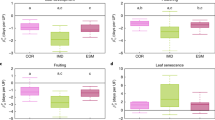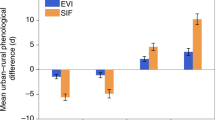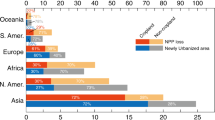Abstract
Plant and animal phenology is shifting in response to urbanization, with most hypotheses focusing on the ‘urban heat island’ (UHI) effect as the driver. However, generalities regarding the direction and magnitude of phenological response to urbanization have not yet emerged because most studies have focused on remote-sensed vegetative phenologies or at local scales with relatively few species. Furthermore, how urbanization interacts with broad-scale climate gradients remains an unknown but important component of anthropogenically driven phenological change. Here, we used a database with >22 million in situ plant phenological observations from the United States and Europe to study the joint influence of varying human population density, which serves as an urbanization measure, and of regional temperature on median flowering and leaf-out dates across a wide plant phylogenetic spectrum. Separately, increasing population density and warmer regional temperature both advanced plant flowering and leaf-out. However, the influence of human population density on plant flowering and leaf-out depends on the regional temperature: high population density advanced plant phenology in cold areas but this effect disappeared or even reversed in warm areas. UHI effects (as measured by daily land surface temperature) alone cannot explain the overall influence of urbanization on plant phenology, suggesting that urbanization also affects plant phenology via other mechanisms. Shorter plants with large specific leaf areas and early flower or leaf-out dates were most affected by urbanization and temperature changes. Our study provides strong empirical evidence that the influence of urbanization on plant phenology varies with regional temperature. Therefore, robust understanding and accurate prediction of phenological changes must take this interaction into account.
This is a preview of subscription content, access via your institution
Access options
Access Nature and 54 other Nature Portfolio journals
Get Nature+, our best-value online-access subscription
$29.99 / 30 days
cancel any time
Subscribe to this journal
Receive 12 digital issues and online access to articles
$119.00 per year
only $9.92 per issue
Buy this article
- Purchase on Springer Link
- Instant access to full article PDF
Prices may be subject to local taxes which are calculated during checkout


flower and leaf silhouettes reproduced from PhyloPic under a Creative Commons licence CC0 1.0
Similar content being viewed by others
Data availability
All data used in this study are available online at https://www.plantphenology.org. See Methods for details about data sources.
Code availability
Key R codes used in this study are available at Github (https://github.com/daijiang/Phenology_NEE) and are permanently archived at Zenodo (https://zenodo.org/badge/latestdoi/202783130).
References
Steffen, W., Broadgate, W., Deutsch, L., Gaffney, O. & Ludwig, C. The trajectory of the Anthropocene: the great acceleration. Anthropocene Rev. 2, 81–98 (2015).
Boivin, N. L. et al. Ecological consequences of human niche construction: examining long-term anthropogenic shaping of global species distributions. Proc. Natl Acad. Sci. USA 113, 6388–6396 (2016).
Grimm, N. B. et al. Global change and the ecology of cities. Science 319, 756–760 (2008).
Hansen, A. J. et al. Effects of exurban development on biodiversity: patterns, mechanisms, and research needs. Ecol. Appl. 15, 1893–1905 (2005).
Theobald, D. M. Landscape patterns of exurban growth in the USA from 1980 to 2020. Ecol. Soc. 10, 32 (2005).
Neil, K. & Wu, J. Effects of urbanization on plant flowering phenology: a review. Urban Ecosyst. 9, 243–257 (2006).
Jochner, S. & Menzel, A. Urban phenological studies—past, present, future. Environ. Pollut. 203, 250–261 (2015).
Cleland, E. E., Chuine, I., Menzel, A., Mooney, H. A. & Schwartz, M. D. Shifting plant phenology in response to global change. Trends Ecol. Evol. 22, 357–365 (2007).
Forrest, J. & Miller-Rushing, A. J. Toward a synthetic understanding of the role of phenology in ecology and evolution. Phil. Trans. R. Soc. Lond. B 365, 3101–3112 (2010).
CaraDonna, P. J., Iler, A. M. & Inouye, D. W. Shifts in flowering phenology reshape a subalpine plant community. Proc. Natl Acad. Sci. USA 111, 4916–4921 (2014).
White, M. A., Nemani, R. R., Thornton, P. E. & Running, S. W. Satellite evidence of phenological differences between urbanized and rural areas of the eastern United States deciduous broadleaf forest. Ecosystems 5, 260–273 (2002).
Li, X. et al. Response of vegetation phenology to urbanization in the conterminous United States. Glob. Change Biol. 23, 2818–2830 (2017).
White, M. A. et al. Intercomparison, interpretation, and assessment of spring phenology in North America estimated from remote sensing for 1982–2006. Glob. Change Biol. 15, 2335–2359 (2009).
Gazal, R. et al. GLOBE students, teachers, and scientists demonstrate variable differences between urban and rural leaf phenology. Glob. Change Biol. 14, 1568–1580 (2008).
Jochner, S., Alves-Eigenheer, M., Menzel, A. & Morellato, L. P. C. Using phenology to assess urban heat islands in tropical and temperate regions. Int. J. Climatol. 33, 3141–3151 (2013).
Stucky, B. J. et al. The plant phenology ontology: a new informatics resource for large-scale integration of plant phenology data. Front. Plant Sci. 9, 517 (2018).
Wolkovich, E. M. et al. Warming experiments underpredict plant phenological responses to climate change. Nature 485, 494–497 (2012).
Fu, Y. H. et al. Declining global warming effects on the phenology of spring leaf unfolding. Nature 526, 104–107 (2015).
Ibbáñez, I. et al. Forecasting phenology under global warming. Phil. Trans. R. Soc. Lond. B 365, 3247–3260 (2010).
Diamond, S. E. et al. Unexpected phenological responses of butterflies to the interaction of urbanization and geographic temperature. Ecology 95, 2613–2621 (2014).
Scranton, K. & Amarasekare, P. Predicting phenological shifts in a changing climate. Proc. Natl Acad. Sci. USA 114, 13212–13217 (2017).
Wienert, U. & Kuttler, W. The dependence of the urban heat island intensity on latitude—a statistical approach. Meteorol. Z. 14, 677–686 (2005).
Wielgolaski, F. E. Phenological modifications in plants by various edaphic factors. Int. J. Biometeorol. 45, 196–202 (2001).
Han, G. & Xu, J. Land surface phenology and land surface temperature changes along an urban–rural gradient in Yangtze River delta, China. Environ. Manage. 52, 234–249 (2013).
Somers-Yeates, R. et al. Light pollution is associated with earlier tree budburst across the United Kingdom. Proc. R. Soc. B 283, 20160813 (2016).
Škvareninová, J. et al. Effects of light pollution on tree phenology in the urban environment. Morav. Geogr. Rep. 25, 282–290 (2017).
Honour, S. L., Bell, J. N. B., Ashenden, T. W., Cape, J. N. & Power, S. A. Responses of herbaceous plants to urban air pollution: effects on growth, phenology and leaf surface characteristics. Environ. Pollut. 157, 1279–1286 (2009).
Davies, T. J. et al. Phylogenetic conservatism in plant phenology. J. Ecol. 101, 1520–1530 (2013).
CaraDonna, P. J. & Inouye, D. W. Phenological responses to climate change do not exhibit phylogenetic signal in a subalpine plant community. Ecology 96, 355–361 (2015).
Rafferty, N. E. & Nabity, P. D. A global test for phylogenetic signal in shifts in flowering time under climate change. J. Ecol. 105, 627–633 (2017).
Mant, J. G., Schiestl, F. P., Peakall, R. & Weston, P. H. A phylogenetic study of pollinator conservatism among sexually deceptive orchids. Evolution 56, 888–898 (2002).
Kharouba, H. M. et al. Global shifts in the phenological synchrony of species interactions over recent decades. Proc. Natl Acad. Sci. USA 115, 5211–5216 (2018).
Richardson, A. D. et al. Ecosystem warming extends vegetation activity but heightens vulnerability to cold temperatures. Nature 560, 368–371 (2018).
Zohner, C. M., Benito, B. M., Svenning, J.-C. & Renner, S. S. Day length unlikely to constrain climate-driven shifts in leaf-out times of northern woody plants. Nat. Clim. Change 6, 1120 (2016).
Damgaard, C. A critique of the space-for-time substitution practice in community ecology. Trends Ecol. Evol. 34, 416–421 (2019).
Pau, S. et al. Predicting phenology by integrating ecology, evolution and climate science. Glob. Change Biol. 17, 3633–3643 (2011).
Templ, B. et al. Pan European phenological database (pep725): a single point of access for European data. Int. J. Biometeorol. 62, 1109–1113 (2018).
Betancourt, J. L. et al. Implementing a US national phenology network. Eos (Washington DC) 86, 539–539 (2005).
Elmendorf, S. C. et al. The plant phenology monitoring design for the national ecological observatory network. Ecosphere 7, e01303 (2016).
Boyle, B. et al. The taxonomic name resolution service: an online tool for automated standardization of plant names. BMC Bioinformatics 14, 16 (2013).
Chamberlain, D. & Szocs, E. Taxize: taxonomic search and retrieval. F1000Res. 2, 191 (2013).
Imhoff, M. L., Zhang, P., Wolfe, R. E. & Bounoua, L. Remote sensing of the urban heat island effect across biomes in the continental USA. Remote Sens. Environ. 114, 504–513 (2010).
Fang, Y. & Jawitz, J. W. High-resolution reconstruction of the United States human population distribution, 1790 to 2010. Sci. Data 5, 180067 (2018).
Menzel, A. et al. European phenological response to climate change matches the warming pattern. Glob. Change Biol. 12, 1969–1976 (2006).
Fu, Y. H. et al. Recent spring phenology shifts in western central Europe based on multiscale observations. Glob. Ecol. Biogeogr. 23, 1255–1263 (2014).
Willmott, C. J. & Matsuura, K. Terrestrial air temperature and precipitation: monthly and annual time series (1950–1999). ESRL https://www.esrl.noaa.gov/psd/data/gridded/data.UDel_AirT_Precip.html (2001).
Fick, S. E. & Hijmans, R. J. WorldClim 2: new 1-km spatial resolution climate surfaces for global land areas. Int. J. Climatol. 37, 4302–4315 (2017).
Harris, I., Jones, P., Osborn, T. & Lister, D. Updated high-resolution grids of monthly climatic observations—the CRU TS3.10 dataset. Int. J. Climatol. 34, 623–642 (2014).
MODIS/Terra Land Surface Temperature and Emissivity Monthly I3 Global 0.05 Deg CMG v.6. NASA EOSDIS Land Processes DAAC (USGS, 2015); https://doi.org/10.5067/MODIS/MOD11C3.006
Smith, S. A. & Brown, J. W. Constructing a broadly inclusive seed plant phylogeny. Am. J. Bot. 105, 302–314 (2018).
Kattge, J. et al. TRY—a global database of plant traits. Glob. Change Biol. 17, 2905–2935 (2011).
Maitner, B. S. et al. The BIEN R package: a tool to access the botanical information and ecology network (BIEN) database. Methods Ecol. Evol. 9, 373–379 (2018).
Barr, D. J., Levy, R., Scheepers, C. & Tily, H. J. Random effects structure for confirmatory hypothesis testing: keep it maximal. J. Mem. Lang. 68, 255–278 (2013).
Johnson, J. B. & Omland, K. S. Model selection in ecology and evolution. Trends Ecol. Evol. 19, 101–108 (2004).
Bates, D., Mächler, M., Bolker, B. & Walker, S. Fitting linear mixed-effects models using lme4. J. Stat. Softw. 67, 1–48 (2015).
Kuznetsova, A., Brockhoff, P. B. & Christensen, R. H. B. lmerTest package: tests in linear mixed effects models. J. Stat. Softw. 82, 1–26 (2017).
Ives, A. R. R2s for correlated data: phylogenetic models, LMMs, and GLMMs. Syst. Biol. 68, 234–251 (2018).
Ives, A. R. & Li, D. rr2: an R package to calculate R2s for regression models. J. Open Source Softw. 3, 1028 (2018).
Blomberg, S. P., Garland, T. & Ives, A. R. Testing for phylogenetic signal in comparative data: behavioral traits are more labile. Evolution 57, 717–745 (2003).
Pagel, M. Inferring the historical patterns of biological evolution. Nature 401, 877–884 (1999).
Acknowledgements
We thank A. R. Ives and E. G. Denny for helpful comments on the manuscript. Data were provided by USA-NPN and the many participants who contribute to its Nature’s Notebook programme, the Pan European Phenology Dataset and the National Ecological Observatory Network. B.B. was supported by an NSF-ABI Award (no. 1458034). A grant from the US Geological Survey under Grant/Cooperative Agreement no. G16AC00268 to R.P.G., and support for J.D. from an NSF-SAVI Award (no. 1321595), were critical in development of PPO and associated data-processing tools upon which this contribution is built.
Author information
Authors and Affiliations
Contributions
D.L., B.J.S., B.B. and R.P.G designed the study. B.J.S. J.D. and R.P.G. compiled the database. D.L. analysed the data and all authors discussed the results. D.L. wrote the manuscript with substantial input from R.P.G., B.J.S. and B.B. All authors commented on the manuscript and approved the final version of the manuscript.
Corresponding author
Ethics declarations
Competing interests
The authors declare no competing interests.
Additional information
Publisher’s note Springer Nature remains neutral with regard to jurisdictional claims in published maps and institutional affiliations.
Extended data
Extended Data Fig. 1
Human population density of 10 km by 10 km grid cells of the USA (the 2010s) and Europe (2011).
Extended Data Fig. 2
Long-term average temperature from November to May of the USA and Europe based on three commonly used datasets. See Methods for details about each dataset.
Extended Data Fig. 3 Phylogeny, estimated coefficients (conditional modes) based on random terms of linear mixed models, and functional traits for all 136 plant species.
Note that only a fraction of these species has both flowering and leaf-out data. The intercepts can be used as approximates for plant phenology (day of year), while the slopes (Pop., Temp., and Temp.:Pop.) were estimates of phenological shifts.
Extended Data Fig. 4 Relationships between shifts in plant flowering and functional traits.
Median flowering times were estimated as the conditional modes of random term intercept of the best linear mixed model in Table 1 and used as a functional trait. Shifts in flowering time were estimated as conditional modes of random slopes of the best linear mixed model in Table 1. Each point presents a species. Regression lines in red indicate significant relationships.
Extended Data Fig. 5 Relationships between shifts in plant leaf-out and functional traits.
Median leaf-out times were estimated as the conditional modes of random term intercept of the best linear mixed model in Table 1 and used as a functional trait. Shifts in leaf-out time were estimated as conditional modes of random slopes of the best linear mixed model in Table 1. Each point presents a species. Regression lines in red indicate significant relationships.
Supplementary information
Supplementary Information
Supplementary Tables 1–7.
Rights and permissions
About this article
Cite this article
Li, D., Stucky, B.J., Deck, J. et al. The effect of urbanization on plant phenology depends on regional temperature. Nat Ecol Evol 3, 1661–1667 (2019). https://doi.org/10.1038/s41559-019-1004-1
Received:
Accepted:
Published:
Issue Date:
DOI: https://doi.org/10.1038/s41559-019-1004-1
This article is cited by
-
Opportunistic plant observations reveal spatial and temporal gradients in phenology
npj Biodiversity (2024)
-
Climate, landscape, and life history jointly predict multidecadal community mosquito phenology
Scientific Reports (2023)
-
Mass production of unvouchered records fails to represent global biodiversity patterns
Nature Ecology & Evolution (2023)
-
Advances in spring leaf phenology are mainly triggered by elevated temperature along the rural-urban gradient in Beijing, China
International Journal of Biometeorology (2023)
-
Urban tree composition is associated with breeding success of a passerine bird, but effects vary within and between years
Oecologia (2023)



